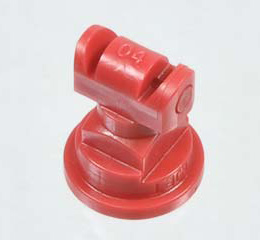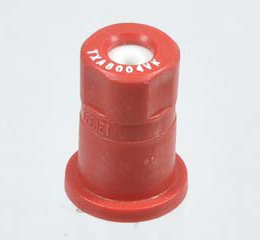 Sprayer tips can be made from various materials, mainly soft metal (aluminum or brass), polypropylene, stainless steel, hardened stainless steel, or ceramic.
Sprayer tips can be made from various materials, mainly soft metal (aluminum or brass), polypropylene, stainless steel, hardened stainless steel, or ceramic.
When choosing the nozzle for your sprayer application, think about the nozzle’s cost, its longevity/durability, and its performance/accuracy. (See Tips For Choosing The Right Sprayer Nozzle.)
The material it’s made of will play an integral role in meeting your needs.
All-poly and poly tips with stainless steel inserts are those most commonly used on agricultural sprayers, and arguably the most economical in the long run. Nozzles made with hardened stainless steel are more commonly used in industrial sprayers.
Sprayers used in lawn and turf applications are known to have the soft metal nozzles on them, although Lowell Graybill of CropCare Equipment Sales & Technical Support feels that may not be the ideal choice in the long run.
 “The wear resistance factor is low on the aluminum and brass nozzles,” he explained. “When they are new, they are fine, but not in the long run.”
“The wear resistance factor is low on the aluminum and brass nozzles,” he explained. “When they are new, they are fine, but not in the long run.”
Wear, pressure, and the product being sprayed can affect nozzle performance. How many gallons are being sprayed through a nozzle is also a concern. “So, if a grower needs to maintain 50-150 acres and sprays three times a year, he would be fine with a brass nozzle,” Graybill said.
In cases where an ag sprayer is used more frequently, at higher pressure, a material with higher resistance needs to be used.
“A poly nozzle is one of the most affordable nozzles to buy and is now known to be just about as wearable as stainless steel, if not as wearable,” Graybill said. The process to make poly nozzles is less expensive.
Another benefit to choosing poly is that those nozzles will be color coded. In the field, that can be a big time-saver. Farmers can do a quick check down the length of the boom to be sure nozzles match and be certain the rates are synced.
“More and more guys are using multiple nozzles for different types of applications,” Graybill added. “It would be more time-consuming and confusing to change nozzles each time if they weren’t color matched.”
Most standard rate nozzles have the quick cap capabilities.
Stainless steel nozzles, a bit more expensive than poly, are available in many styles. In many cases, a color coded poly housing with a stainless steel insert combines aspects of better wear resistance and convenience. If you’re spraying at a rate of over 30-gallon-per-acre, you may want to consider a stainless nozzle over one that is entirely poly. In spraying a liquid fertilizer at high volume, farmers should be using a stainless nozzle.

“That’s not the case in use,” said Graybill, “but it might be the case in cleaning. If a farmer is going to use a pocket knife or torch clip cleaner to clean out a ceramic nozzle, that’s not the thing to use. A soft bristle brush is best. Another consideration would be to use a ceramic nozzle housed in a poly covering.”
In vegetable production, specific products that will be sprayed may be a bit abrasive. In those uses, a higher-wearing nozzle is needed and stainless or ceramic should be considered.
Regardless of nozzle material, all nozzles should be calibrated annually for optimal performance.


